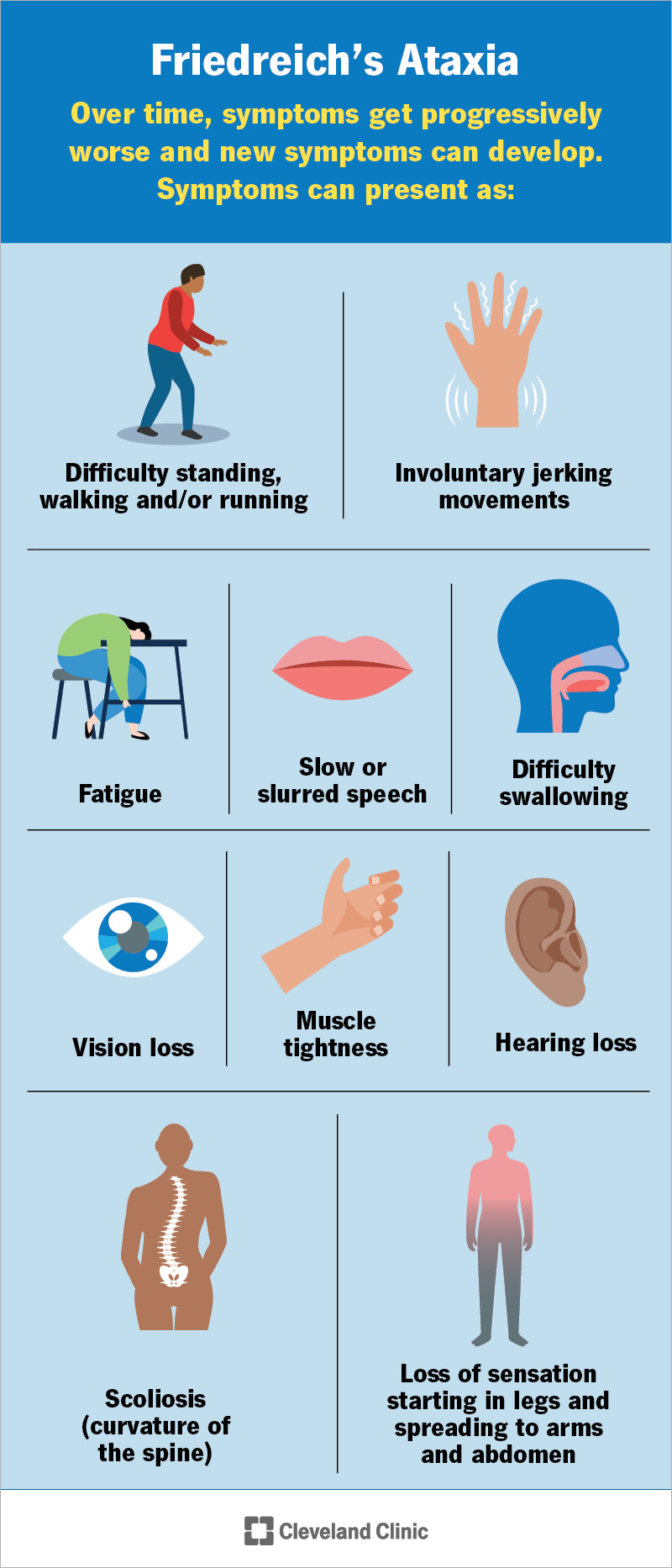Friedreich’s ataxia (FA or FRDA) is a rare genetic disorder that affects how you move and keep your balance. It usually starts in childhood and gets worse over time. Complications may affect your heart. While there’s no cure, new treatments and therapies can help manage symptoms and improve your quality of life for as long as possible.
Advertisement
Cleveland Clinic is a non-profit academic medical center. Advertising on our site helps support our mission. We do not endorse non-Cleveland Clinic products or services. Policy
Friedreich's ataxia (FA or FRDA) is a rare genetic condition that causes progressive nervous system damage. It may impact your heart function over time. It affects your movement, balance and coordination (ataxia). Symptoms usually start in childhood and get worse.
Advertisement
Cleveland Clinic is a non-profit academic medical center. Advertising on our site helps support our mission. We do not endorse non-Cleveland Clinic products or services. Policy
FA affects approximately 1 in every 50,000 people in the United States. Globally, it affects 1 in every 40,000 people.
If you’re a parent or caregiver, it can be alarming to see your child struggle with movement or coordination. You may worry about how it will affect their life. The best option is to see a specialist who can answer your questions and guide you through what to expect.
Most cases of FA are known as “typical” when they develop before age 25. There are also two, less common, atypical types:
LOFA and VLOFA usually progress more slowly than typical FA.

Symptoms of FA usually begin between the ages of 5 and 15. But some people experience symptoms starting at age 2 or age 50. Symptoms may include:
Advertisement
The first signs are usually difficulty standing, walking and balance issues (gait ataxia). Over time, these get worse and new symptoms may develop.
Friedreich’s ataxia is a genetic condition — a change (variant) in the FXN gene causes the disease. This gene carries the code for frataxin.
Frataxin is a protein in the energy-producing parts of cells called mitochondria. Although scientists don’t fully understand its role, frataxin helps mitochondria do their job. The gene change that causes FA disrupts the production of frataxin.
Without the expected level of frataxin, certain cells in your body produce less energy. This creates a buildup of toxic byproducts called oxidative stress. It damages your cells and causes symptoms.
Friedreich’s ataxia develops when you inherit two changed copies of the FXN gene. You get one from each biological parent. Healthcare providers call this an autosomal recessive inheritance pattern.
The biological parents of a person with an autosomal recessive condition each carry one copy of the changed gene. But they typically don’t show signs and symptoms of the condition.
As this is a genetic condition, you can’t prevent it.
Many people with FA develop heart issues. The most common ones include:
Other heart complications may include:
About 3 out of 10 people with FRDA develop diabetes. This is due to damage that affects insulin production in your pancreas, which leads to high blood sugar.
A healthcare provider will ask about your symptoms and medical history. They’ll then do a thorough physical exam and neurological exam.
Your provider will likely recommend a variety of tests. Genetic testing is the main test that can confirm FRDA. Your provider may offer more tests to see which parts of your body the condition affects. These include:
Advertisement
In 2023, the U.S. Food and Drug Administration (FDA) approved the first medication specifically for Friedreich’s ataxia — omaveloxolone (SKYCLARYS™) — for people aged 16 and older. Studies show this medication can help improve neurological function and ataxia. Research is ongoing to understand the possible long-term effects of this medication. Omaveloxolone isn’t a cure for FA.
The main goal of treatment is to manage symptoms and complications. This helps your body work as well as possible for as long as possible. Treatment may include:
FRDA affects everyone differently and at different rates. Your care team will develop an individualized therapy plan that will change as you grow.
As Friedreich’s ataxia is a degenerative condition and worsens over time, people with this condition tend to have a shorter life expectancy than the average population.
Advertisement
FA affects everyone differently. Many people with FRDA live until at least their 30s, and some live into their 60s or beyond.
The most common cause of death in people with FA is hypertrophic cardiomyopathy. This causes thickening of your heart muscle. It may make your heart not pump as well as it should (heart failure), beat dangerously fast (ventricular tachycardia) or lose function (sudden cardiac arrest).
FA affects each person differently. No one can predict you or your child’s outlook with certainty. The best way you can prepare for the future is to talk to your healthcare providers or other specialists who research and treat this condition.
Living with Friedreich’s ataxia can be tough, both in daily life and emotionally. It’s natural to wonder what the future holds or how to make the right choices for you or your child’s health.
Your care team can help you understand what’s happening and create a treatment plan that fits your needs. New treatments and therapies continue to bring hope for better day-to-day living.
As you manage your or your child’s health, don’t forget to care for your emotional well-being, too. Support groups and mental health professionals can help if you’re feeling stressed or overwhelmed.
Advertisement
If you have a neurological condition, you want expert advice. At Cleveland Clinic, we’ll work to create a treatment plan that’s right for you.

Last reviewed on 10/31/2024.
Learn more about the Health Library and our editorial process.